Marketing Plan: Water Purification Station - A Case Study Analysis
VerifiedAdded on 2023/06/15
|10
|1176
|247
Case Study
AI Summary
This case study examines the marketing management strategies employed by a water purification station, focusing on its socially innovative approach to providing clean drinking water to the local community. It assesses the target market, brand value, and competitive landscape, emphasizing the importance of quality, integrity, and environmental conservation through recycling. The study utilizes research methods such as case studies, questionnaires, and interviews to gather data on customer perceptions and competitor strategies. Key theoretical frameworks, including stakeholder theory, triple bottom line, and customer satisfaction theory, are applied to analyze the project's social responsibility and sustainability. Ultimately, the case study concludes that the water purification station is a socially responsible initiative that benefits the community by promoting healthy living and reducing the spread of diseases. Desklib provides access to this document and many other solved assignments for students.
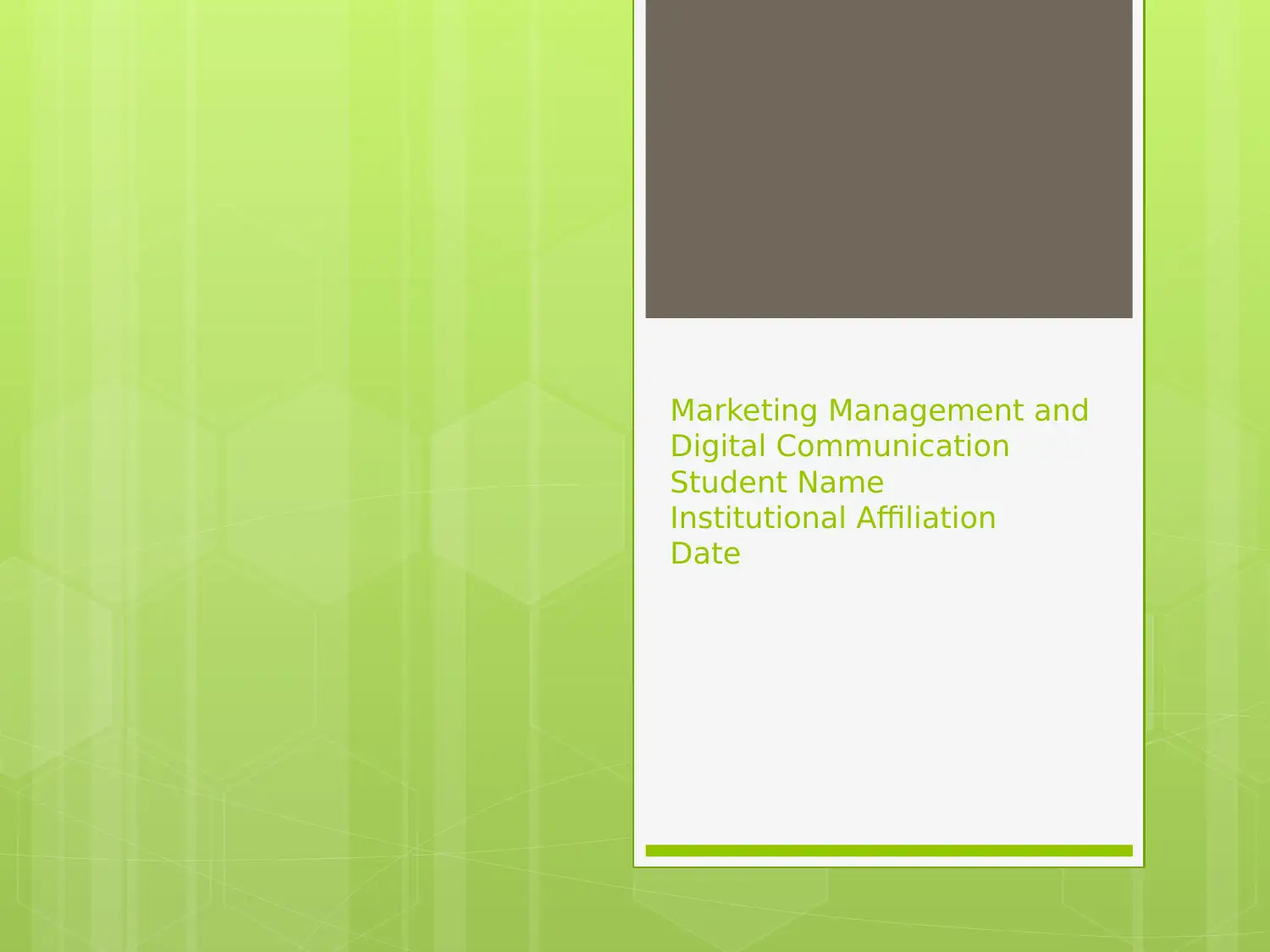
Marketing Management and
Digital Communication
Student Name
Institutional Affiliation
Date
Digital Communication
Student Name
Institutional Affiliation
Date
Paraphrase This Document
Need a fresh take? Get an instant paraphrase of this document with our AI Paraphraser
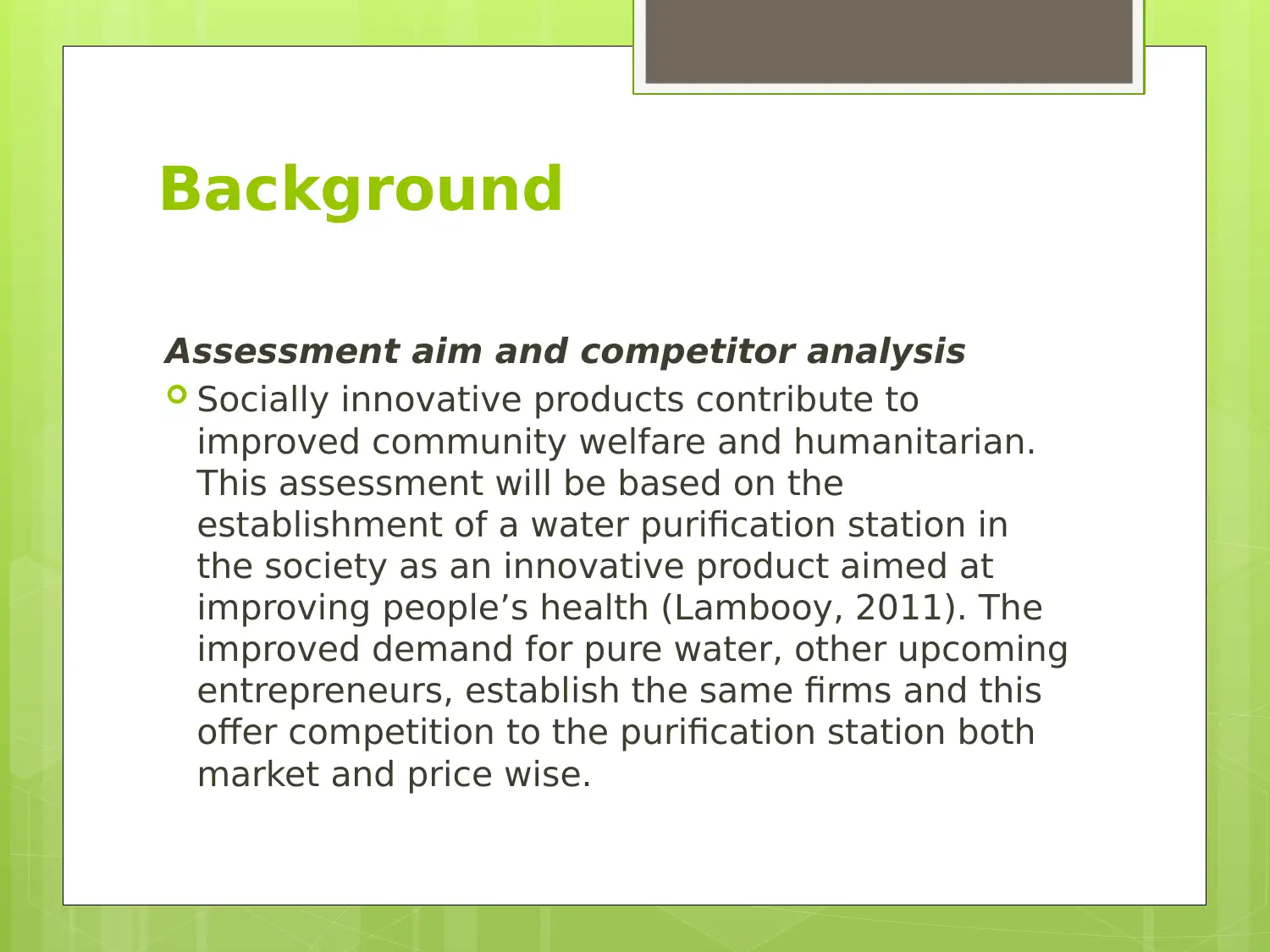
Background
Assessment aim and competitor analysis
Socially innovative products contribute to
improved community welfare and humanitarian.
This assessment will be based on the
establishment of a water purification station in
the society as an innovative product aimed at
improving people’s health (Lambooy, 2011). The
improved demand for pure water, other upcoming
entrepreneurs, establish the same firms and this
offer competition to the purification station both
market and price wise.
Assessment aim and competitor analysis
Socially innovative products contribute to
improved community welfare and humanitarian.
This assessment will be based on the
establishment of a water purification station in
the society as an innovative product aimed at
improving people’s health (Lambooy, 2011). The
improved demand for pure water, other upcoming
entrepreneurs, establish the same firms and this
offer competition to the purification station both
market and price wise.
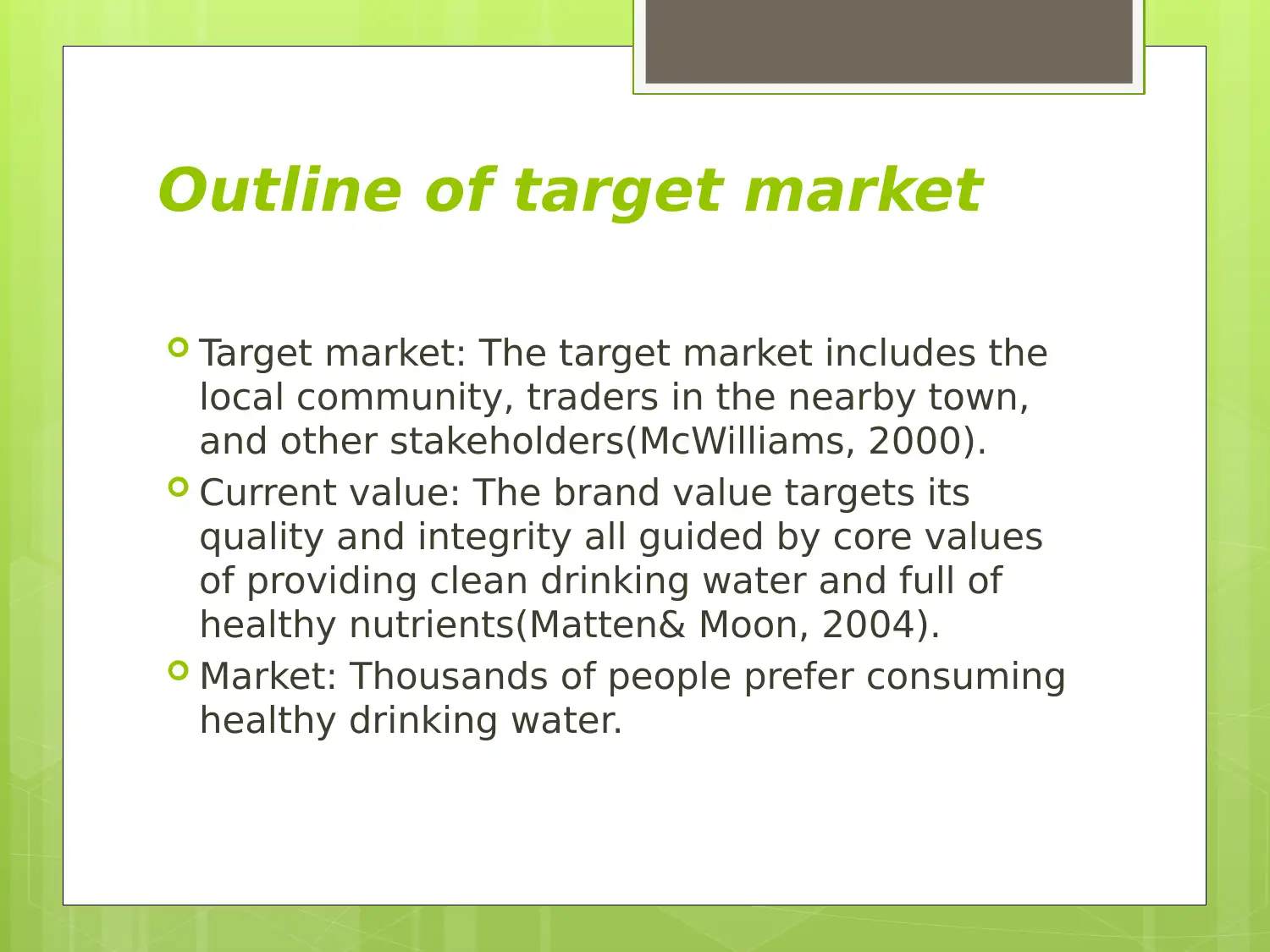
Outline of target market
Target market: The target market includes the
local community, traders in the nearby town,
and other stakeholders(McWilliams, 2000).
Current value: The brand value targets its
quality and integrity all guided by core values
of providing clean drinking water and full of
healthy nutrients(Matten& Moon, 2004).
Market: Thousands of people prefer consuming
healthy drinking water.
Target market: The target market includes the
local community, traders in the nearby town,
and other stakeholders(McWilliams, 2000).
Current value: The brand value targets its
quality and integrity all guided by core values
of providing clean drinking water and full of
healthy nutrients(Matten& Moon, 2004).
Market: Thousands of people prefer consuming
healthy drinking water.
⊘ This is a preview!⊘
Do you want full access?
Subscribe today to unlock all pages.

Trusted by 1+ million students worldwide
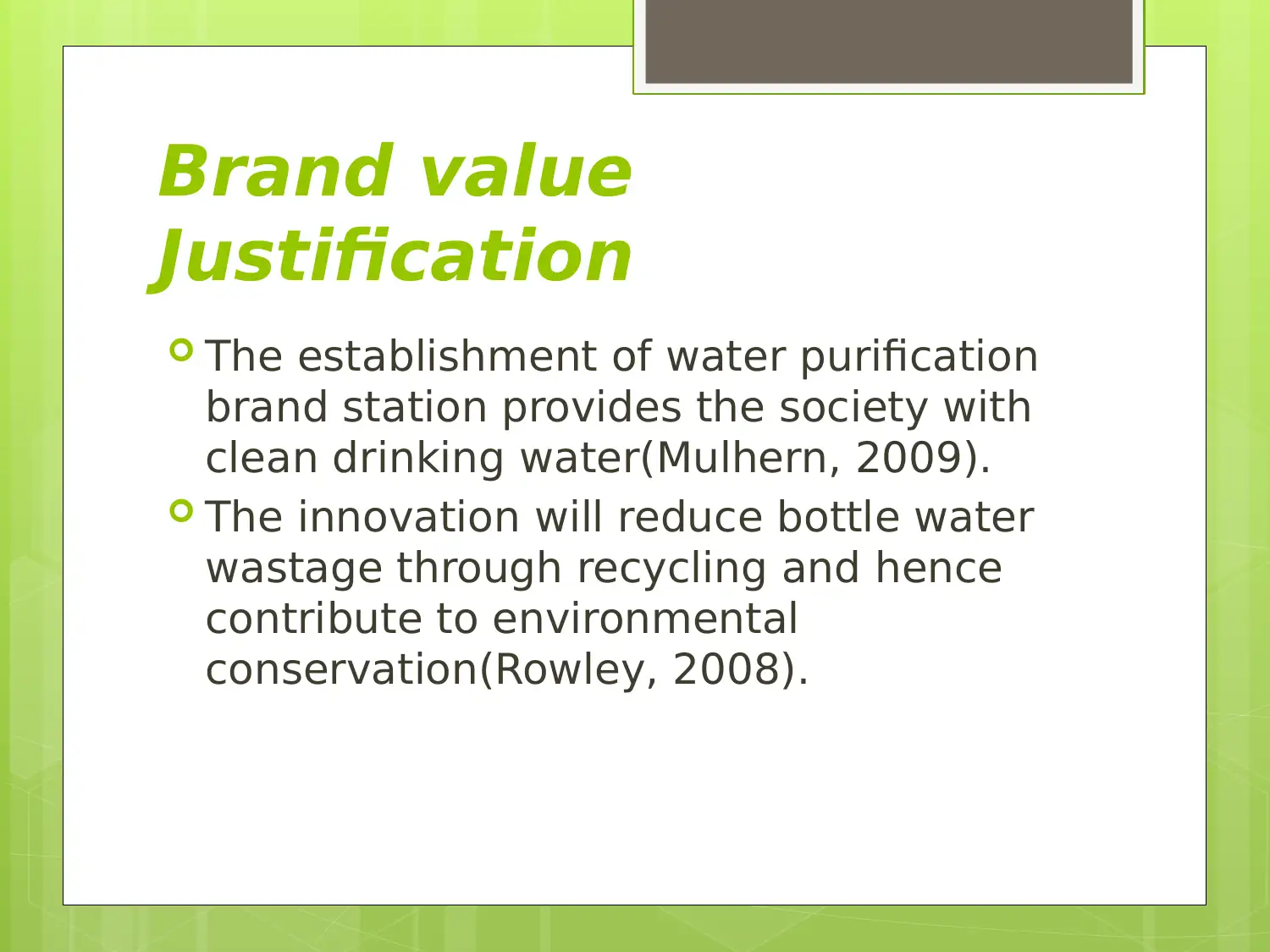
Brand value
Justification
The establishment of water purification
brand station provides the society with
clean drinking water(Mulhern, 2009).
The innovation will reduce bottle water
wastage through recycling and hence
contribute to environmental
conservation(Rowley, 2008).
Justification
The establishment of water purification
brand station provides the society with
clean drinking water(Mulhern, 2009).
The innovation will reduce bottle water
wastage through recycling and hence
contribute to environmental
conservation(Rowley, 2008).
Paraphrase This Document
Need a fresh take? Get an instant paraphrase of this document with our AI Paraphraser
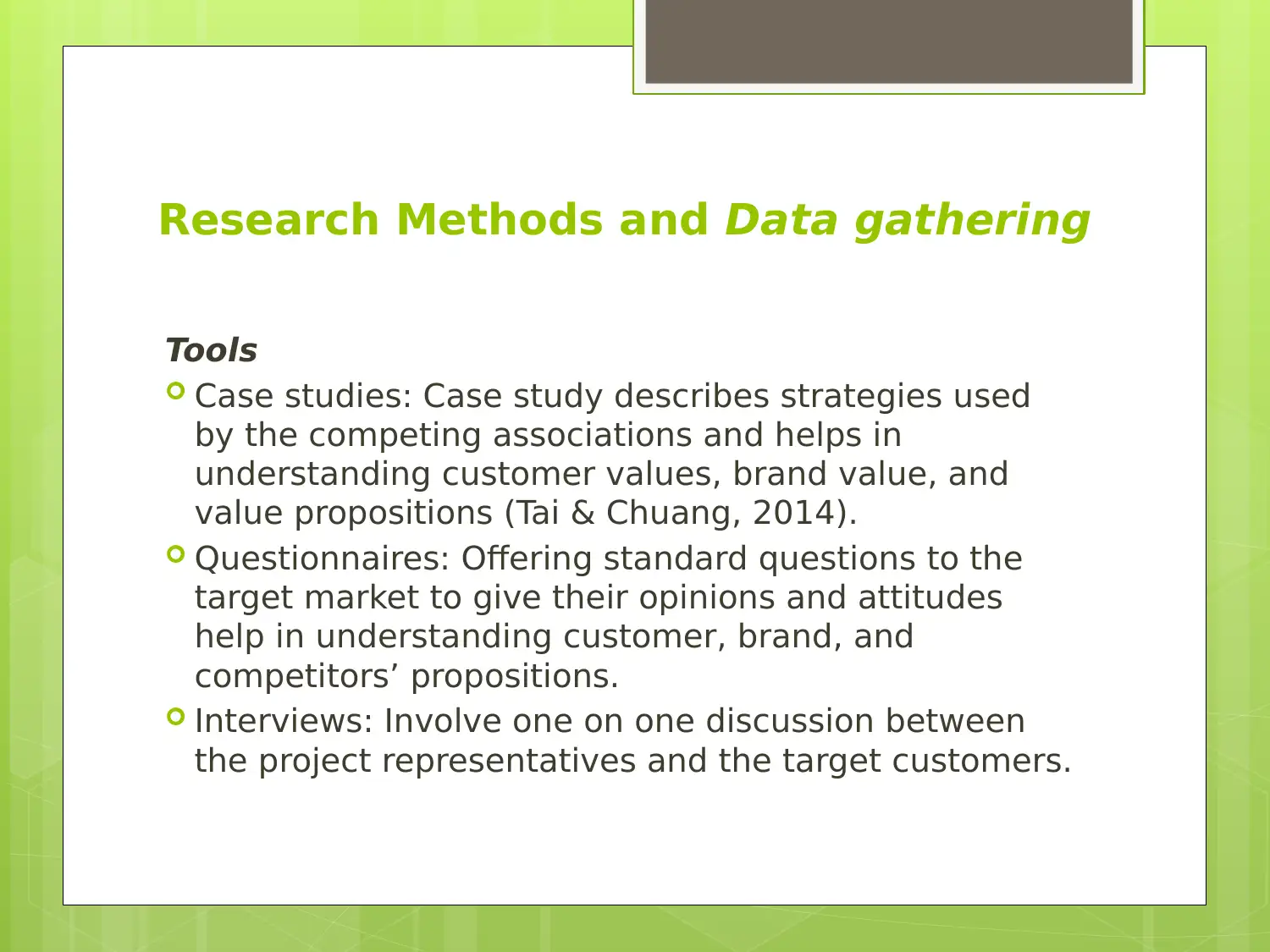
Research Methods and Data gathering
Tools
Case studies: Case study describes strategies used
by the competing associations and helps in
understanding customer values, brand value, and
value propositions (Tai & Chuang, 2014).
Questionnaires: Offering standard questions to the
target market to give their opinions and attitudes
help in understanding customer, brand, and
competitors’ propositions.
Interviews: Involve one on one discussion between
the project representatives and the target customers.
Tools
Case studies: Case study describes strategies used
by the competing associations and helps in
understanding customer values, brand value, and
value propositions (Tai & Chuang, 2014).
Questionnaires: Offering standard questions to the
target market to give their opinions and attitudes
help in understanding customer, brand, and
competitors’ propositions.
Interviews: Involve one on one discussion between
the project representatives and the target customers.
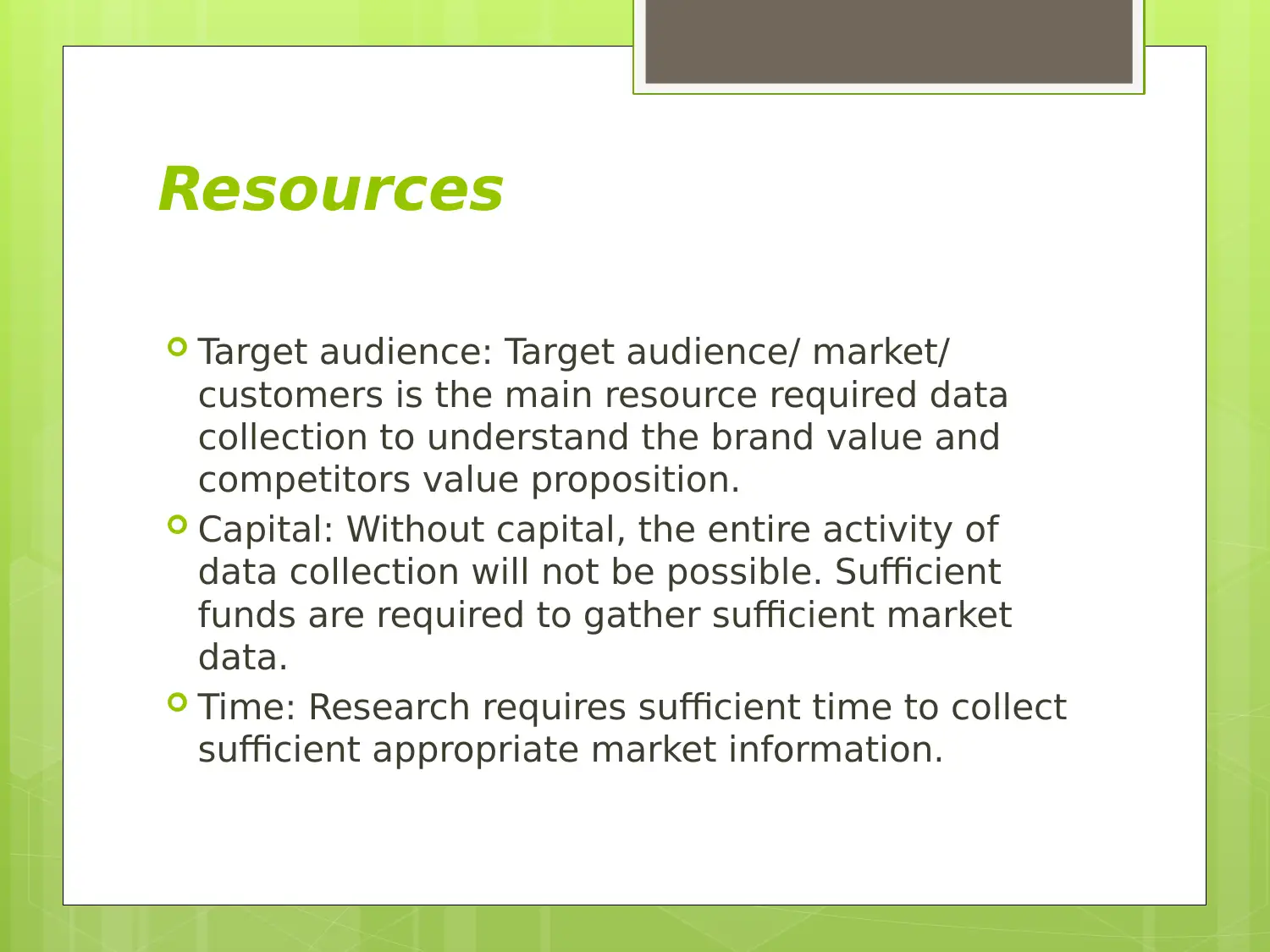
Resources
Target audience: Target audience/ market/
customers is the main resource required data
collection to understand the brand value and
competitors value proposition.
Capital: Without capital, the entire activity of
data collection will not be possible. Sufficient
funds are required to gather sufficient market
data.
Time: Research requires sufficient time to collect
sufficient appropriate market information.
Target audience: Target audience/ market/
customers is the main resource required data
collection to understand the brand value and
competitors value proposition.
Capital: Without capital, the entire activity of
data collection will not be possible. Sufficient
funds are required to gather sufficient market
data.
Time: Research requires sufficient time to collect
sufficient appropriate market information.
⊘ This is a preview!⊘
Do you want full access?
Subscribe today to unlock all pages.

Trusted by 1+ million students worldwide
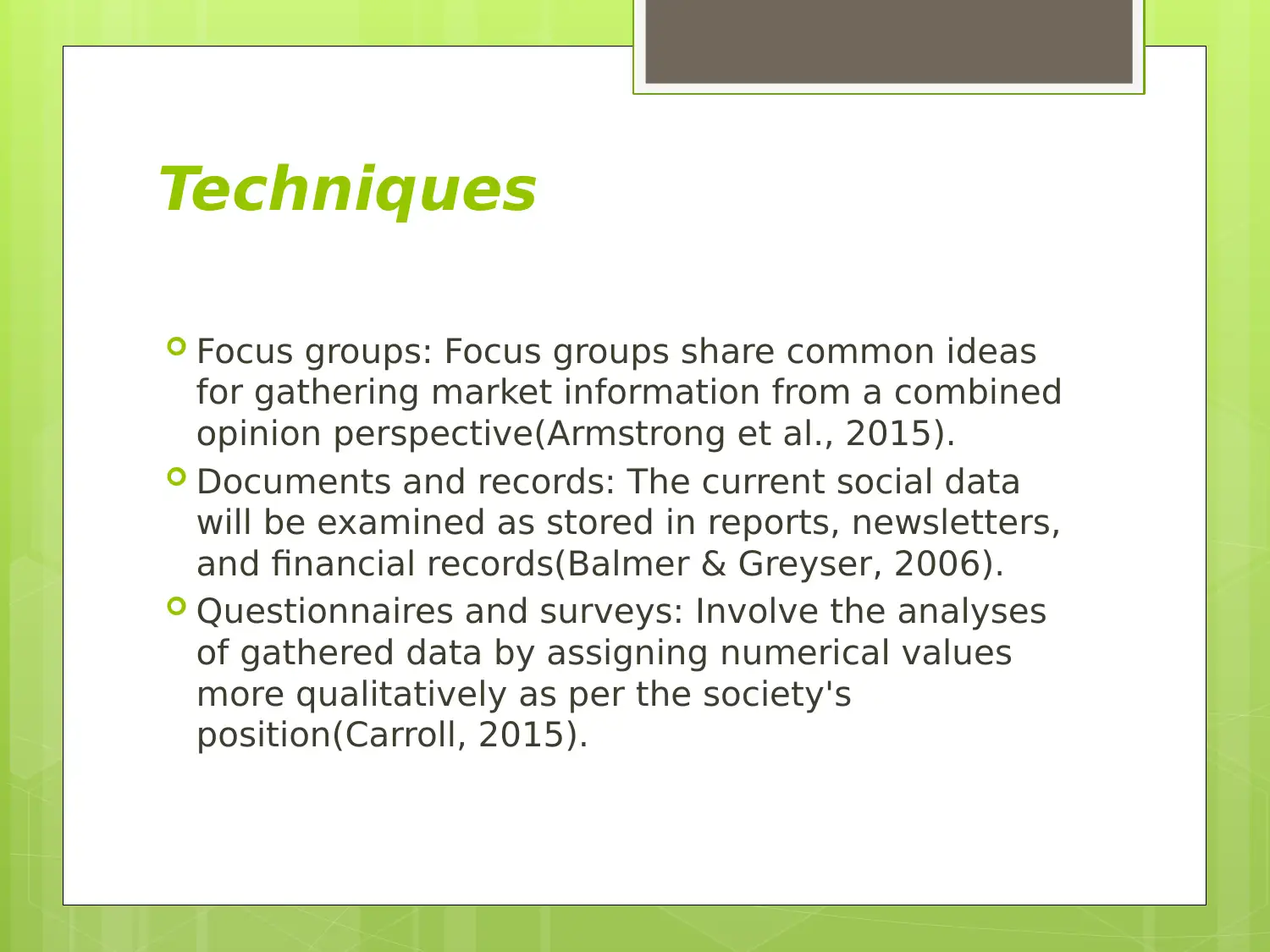
Techniques
Focus groups: Focus groups share common ideas
for gathering market information from a combined
opinion perspective(Armstrong et al., 2015).
Documents and records: The current social data
will be examined as stored in reports, newsletters,
and financial records(Balmer & Greyser, 2006).
Questionnaires and surveys: Involve the analyses
of gathered data by assigning numerical values
more qualitatively as per the society's
position(Carroll, 2015).
Focus groups: Focus groups share common ideas
for gathering market information from a combined
opinion perspective(Armstrong et al., 2015).
Documents and records: The current social data
will be examined as stored in reports, newsletters,
and financial records(Balmer & Greyser, 2006).
Questionnaires and surveys: Involve the analyses
of gathered data by assigning numerical values
more qualitatively as per the society's
position(Carroll, 2015).
Paraphrase This Document
Need a fresh take? Get an instant paraphrase of this document with our AI Paraphraser
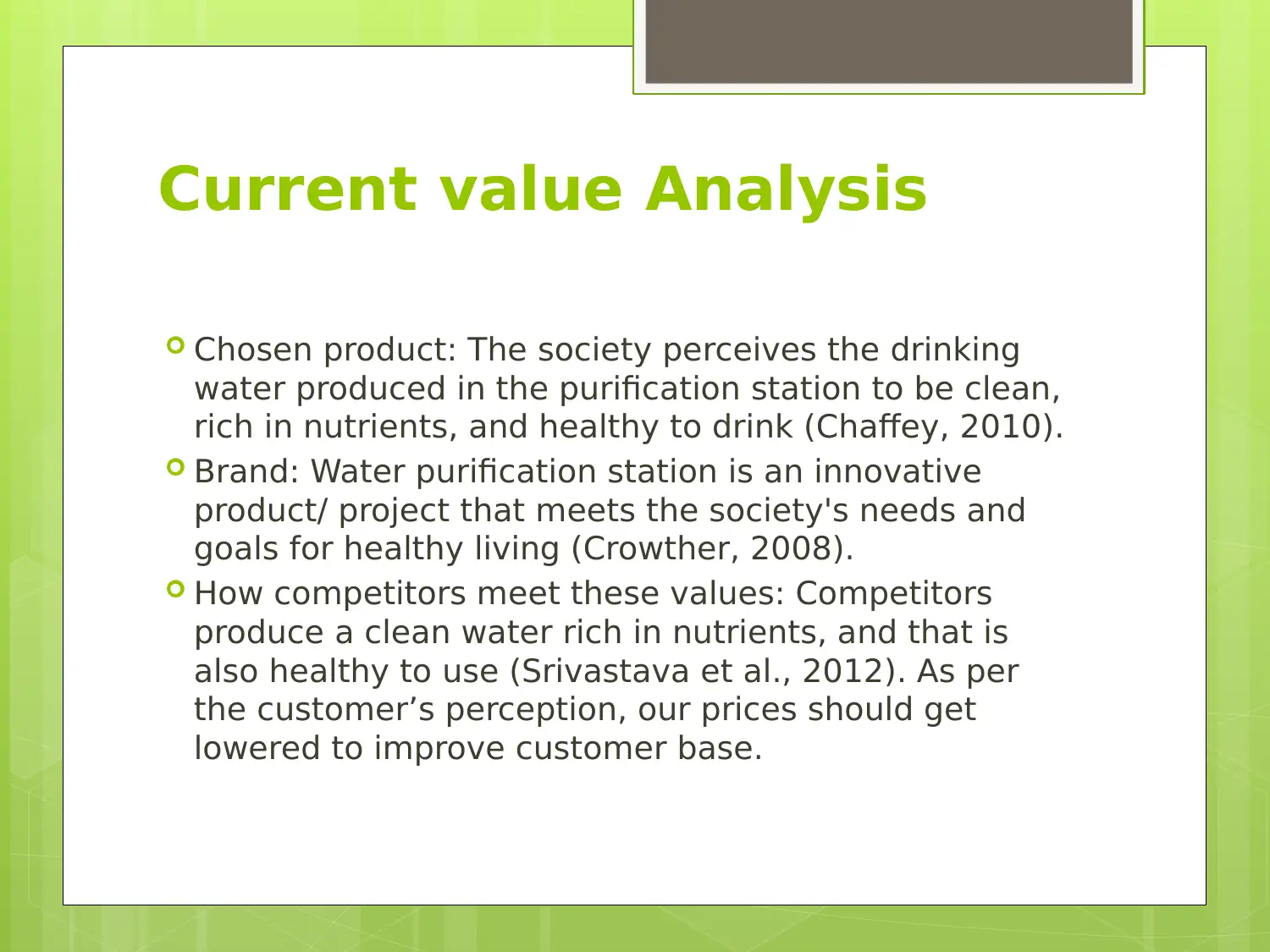
Current value Analysis
Chosen product: The society perceives the drinking
water produced in the purification station to be clean,
rich in nutrients, and healthy to drink (Chaffey, 2010).
Brand: Water purification station is an innovative
product/ project that meets the society's needs and
goals for healthy living (Crowther, 2008).
How competitors meet these values: Competitors
produce a clean water rich in nutrients, and that is
also healthy to use (Srivastava et al., 2012). As per
the customer’s perception, our prices should get
lowered to improve customer base.
Chosen product: The society perceives the drinking
water produced in the purification station to be clean,
rich in nutrients, and healthy to drink (Chaffey, 2010).
Brand: Water purification station is an innovative
product/ project that meets the society's needs and
goals for healthy living (Crowther, 2008).
How competitors meet these values: Competitors
produce a clean water rich in nutrients, and that is
also healthy to use (Srivastava et al., 2012). As per
the customer’s perception, our prices should get
lowered to improve customer base.
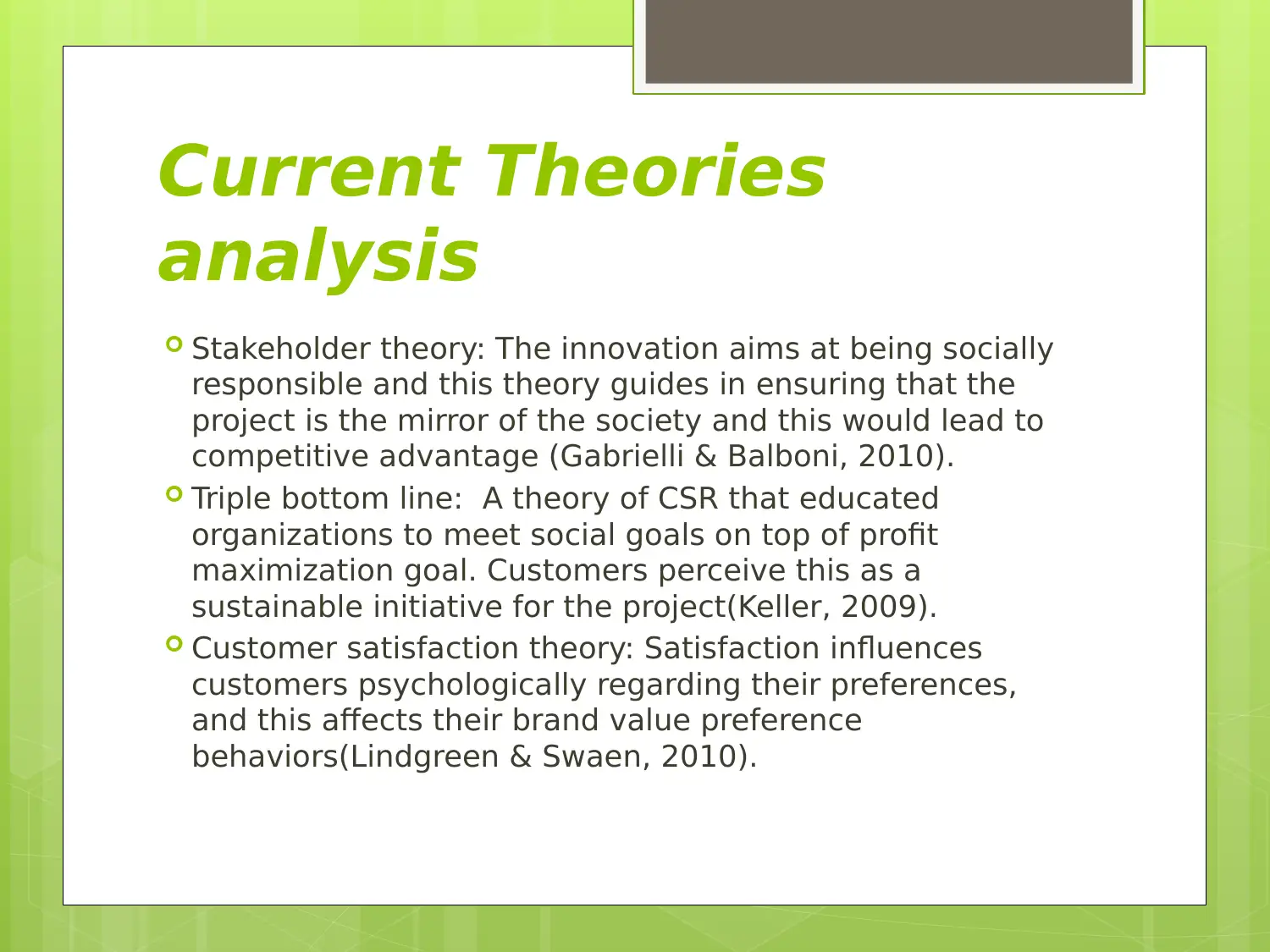
Current Theories
analysis
Stakeholder theory: The innovation aims at being socially
responsible and this theory guides in ensuring that the
project is the mirror of the society and this would lead to
competitive advantage (Gabrielli & Balboni, 2010).
Triple bottom line: A theory of CSR that educated
organizations to meet social goals on top of profit
maximization goal. Customers perceive this as a
sustainable initiative for the project(Keller, 2009).
Customer satisfaction theory: Satisfaction influences
customers psychologically regarding their preferences,
and this affects their brand value preference
behaviors(Lindgreen & Swaen, 2010).
analysis
Stakeholder theory: The innovation aims at being socially
responsible and this theory guides in ensuring that the
project is the mirror of the society and this would lead to
competitive advantage (Gabrielli & Balboni, 2010).
Triple bottom line: A theory of CSR that educated
organizations to meet social goals on top of profit
maximization goal. Customers perceive this as a
sustainable initiative for the project(Keller, 2009).
Customer satisfaction theory: Satisfaction influences
customers psychologically regarding their preferences,
and this affects their brand value preference
behaviors(Lindgreen & Swaen, 2010).
⊘ This is a preview!⊘
Do you want full access?
Subscribe today to unlock all pages.

Trusted by 1+ million students worldwide
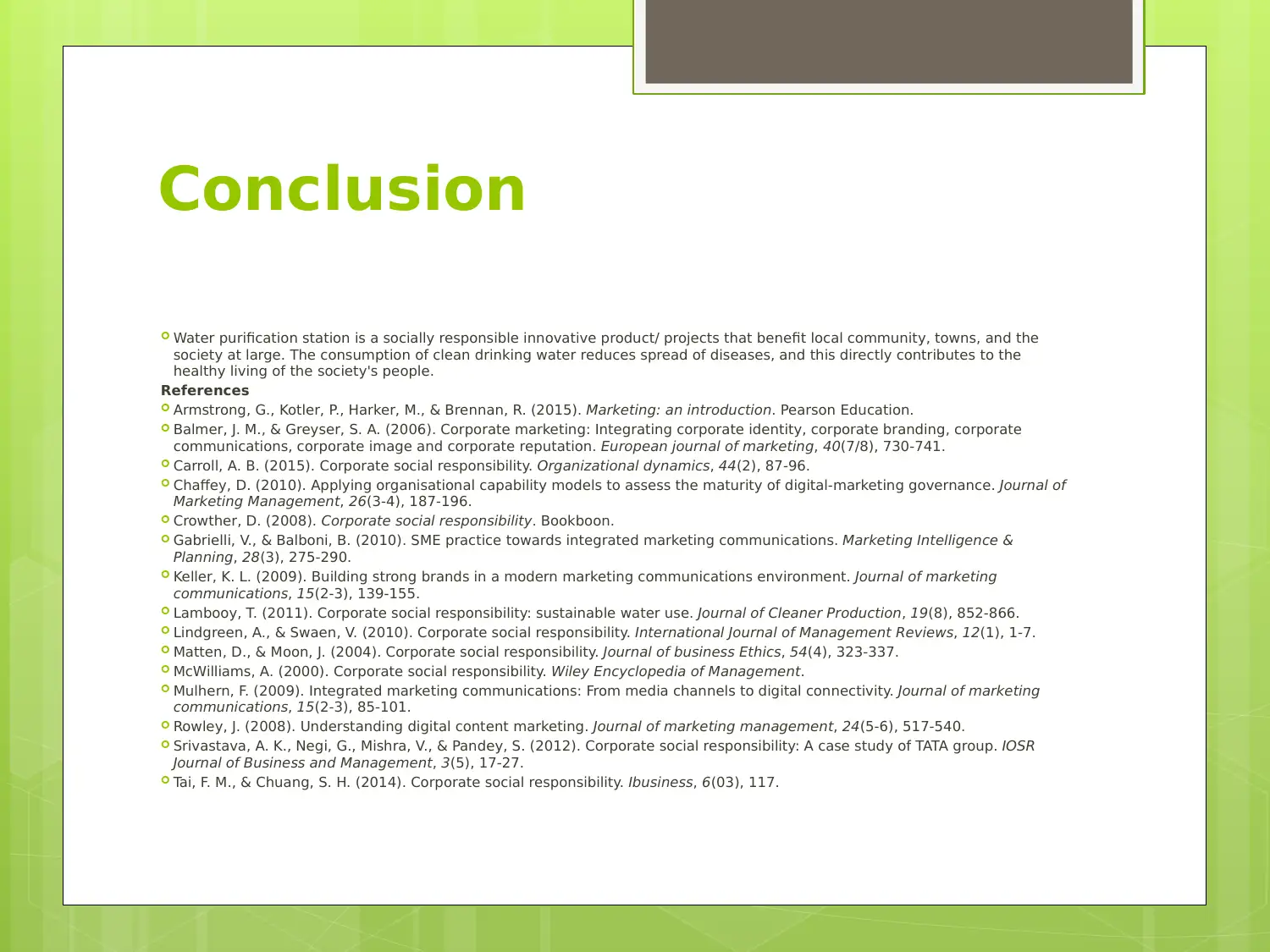
Conclusion
Water purification station is a socially responsible innovative product/ projects that benefit local community, towns, and the
society at large. The consumption of clean drinking water reduces spread of diseases, and this directly contributes to the
healthy living of the society's people.
References
Armstrong, G., Kotler, P., Harker, M., & Brennan, R. (2015). Marketing: an introduction. Pearson Education.
Balmer, J. M., & Greyser, S. A. (2006). Corporate marketing: Integrating corporate identity, corporate branding, corporate
communications, corporate image and corporate reputation. European journal of marketing, 40(7/8), 730-741.
Carroll, A. B. (2015). Corporate social responsibility. Organizational dynamics, 44(2), 87-96.
Chaffey, D. (2010). Applying organisational capability models to assess the maturity of digital-marketing governance. Journal of
Marketing Management, 26(3-4), 187-196.
Crowther, D. (2008). Corporate social responsibility. Bookboon.
Gabrielli, V., & Balboni, B. (2010). SME practice towards integrated marketing communications. Marketing Intelligence &
Planning, 28(3), 275-290.
Keller, K. L. (2009). Building strong brands in a modern marketing communications environment. Journal of marketing
communications, 15(2-3), 139-155.
Lambooy, T. (2011). Corporate social responsibility: sustainable water use. Journal of Cleaner Production, 19(8), 852-866.
Lindgreen, A., & Swaen, V. (2010). Corporate social responsibility. International Journal of Management Reviews, 12(1), 1-7.
Matten, D., & Moon, J. (2004). Corporate social responsibility. Journal of business Ethics, 54(4), 323-337.
McWilliams, A. (2000). Corporate social responsibility. Wiley Encyclopedia of Management.
Mulhern, F. (2009). Integrated marketing communications: From media channels to digital connectivity. Journal of marketing
communications, 15(2-3), 85-101.
Rowley, J. (2008). Understanding digital content marketing. Journal of marketing management, 24(5-6), 517-540.
Srivastava, A. K., Negi, G., Mishra, V., & Pandey, S. (2012). Corporate social responsibility: A case study of TATA group. IOSR
Journal of Business and Management, 3(5), 17-27.
Tai, F. M., & Chuang, S. H. (2014). Corporate social responsibility. Ibusiness, 6(03), 117.
Water purification station is a socially responsible innovative product/ projects that benefit local community, towns, and the
society at large. The consumption of clean drinking water reduces spread of diseases, and this directly contributes to the
healthy living of the society's people.
References
Armstrong, G., Kotler, P., Harker, M., & Brennan, R. (2015). Marketing: an introduction. Pearson Education.
Balmer, J. M., & Greyser, S. A. (2006). Corporate marketing: Integrating corporate identity, corporate branding, corporate
communications, corporate image and corporate reputation. European journal of marketing, 40(7/8), 730-741.
Carroll, A. B. (2015). Corporate social responsibility. Organizational dynamics, 44(2), 87-96.
Chaffey, D. (2010). Applying organisational capability models to assess the maturity of digital-marketing governance. Journal of
Marketing Management, 26(3-4), 187-196.
Crowther, D. (2008). Corporate social responsibility. Bookboon.
Gabrielli, V., & Balboni, B. (2010). SME practice towards integrated marketing communications. Marketing Intelligence &
Planning, 28(3), 275-290.
Keller, K. L. (2009). Building strong brands in a modern marketing communications environment. Journal of marketing
communications, 15(2-3), 139-155.
Lambooy, T. (2011). Corporate social responsibility: sustainable water use. Journal of Cleaner Production, 19(8), 852-866.
Lindgreen, A., & Swaen, V. (2010). Corporate social responsibility. International Journal of Management Reviews, 12(1), 1-7.
Matten, D., & Moon, J. (2004). Corporate social responsibility. Journal of business Ethics, 54(4), 323-337.
McWilliams, A. (2000). Corporate social responsibility. Wiley Encyclopedia of Management.
Mulhern, F. (2009). Integrated marketing communications: From media channels to digital connectivity. Journal of marketing
communications, 15(2-3), 85-101.
Rowley, J. (2008). Understanding digital content marketing. Journal of marketing management, 24(5-6), 517-540.
Srivastava, A. K., Negi, G., Mishra, V., & Pandey, S. (2012). Corporate social responsibility: A case study of TATA group. IOSR
Journal of Business and Management, 3(5), 17-27.
Tai, F. M., & Chuang, S. H. (2014). Corporate social responsibility. Ibusiness, 6(03), 117.
1 out of 10
Related Documents
Your All-in-One AI-Powered Toolkit for Academic Success.
+13062052269
info@desklib.com
Available 24*7 on WhatsApp / Email
![[object Object]](/_next/static/media/star-bottom.7253800d.svg)
Unlock your academic potential
Copyright © 2020–2025 A2Z Services. All Rights Reserved. Developed and managed by ZUCOL.





